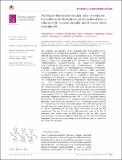Files in this item
Hydrogen-bonded molecular salts of reduced benzothiazole derivatives with carboxylates : a robust R_{2}^{2}(8) supramolecular motif (even when disordered)
Item metadata
| dc.contributor.author | Shaibah, Mohammed A. E. | |
| dc.contributor.author | Sagar, Belakavadi K. | |
| dc.contributor.author | Yathirajan, Hemmige S. | |
| dc.contributor.author | Cordes, David B. | |
| dc.contributor.author | Slawin, Alexandra M. Z. | |
| dc.contributor.author | Harrison, William T. A. | |
| dc.date.accessioned | 2019-02-14T15:30:04Z | |
| dc.date.available | 2019-02-14T15:30:04Z | |
| dc.date.issued | 2019-02-01 | |
| dc.identifier | 257744368 | |
| dc.identifier | 771cfdb6-0b95-4cdc-b0ff-c15c1c5d12a4 | |
| dc.identifier | 85061157335 | |
| dc.identifier | 000457717300015 | |
| dc.identifier.citation | Shaibah , M A E , Sagar , B K , Yathirajan , H S , Cordes , D B , Slawin , A M Z & Harrison , W T A 2019 , ' Hydrogen-bonded molecular salts of reduced benzothiazole derivatives with carboxylates : a robust R_{2}^{2}(8) supramolecular motif (even when disordered) ' , Acta Crystallographica Section E , vol. 75 , no. 2 , pp. 167-174 . https://doi.org/10.1107/S2056989018018224 | en |
| dc.identifier.issn | 2056-9890 | |
| dc.identifier.other | RIS: urn:695BFC309A00A4735BE6AE10CDD82285 | |
| dc.identifier.other | ORCID: /0000-0002-5366-9168/work/54181493 | |
| dc.identifier.other | ORCID: /0000-0002-9527-6418/work/56861528 | |
| dc.identifier.uri | https://hdl.handle.net/10023/17069 | |
| dc.description | HSY thanks UGC for the award of a UGC–BSR Faculty Fellowship for three years. BKS thanks the UGC for the award of a Rajeev Gandhi fellowship. | en |
| dc.description.abstract | The syntheses and structures of five molecular salts of protonated 4,4,7,7-tetramethyl-3a,5,6,7a-tetrahydrobenzothiazol-2-ylamine (C11H 19N 2S +) with different deprotonated carboxylic acids (4-methylbenzoic acid, 4-bromobenzoic acid, 3,5-dinitrobenzoic acid, fumaric acid and succinic acid) are reported, namely 2-amino-4,4,7,7-tetramethyl-4,5,6,7-tetrahydro-1,3-benzothiazol-3-ium 4-methylbenzoate, C11H 19N 2S +·C 8H 7O 2 −, (I), 2-amino-4,4,7,7-tetramethyl-4,5,6,7-tetrahydro-1,3-benzothiazol-3-ium 4-bromobenzoate, C11H 19N 2S +·C 7H 4BrO 2 −, (II), 2-amino-4,4,7,7-tetramethyl-4,5,6,7-tetrahydro-1,3-benzothiazol-3-ium 3,5-dinitrobenzoate, C11H 19N 2S +·C 7H 3N 2O 6 −, (III), bis(2-amino-4,4,7,7-tetramethyl-4,5,6,7-tetrahydro-1,3-benzothiazol-3-ium) fumarate, 2C11H 19N 2S +·C 4H 2O 4 2−,(IV), and the 1:1 co-crystal of bis(2-amino-4,4,7,7-tetramethyl-4,5,6,7-tetrahydro-1,3-benzothiazol-3-ium) succinate and 2-amino-4,4,7,7-tetramethyl-4,5,6,7-tetrahydro-1,3-benzothiazol-3-ium hydrogen succinate 4,4,7,7-tetramethyl-3a,5,6,7a-tetrahydrobenzothiazol-2-ylamine, 1.5C11H 19N 2S +·0.5C 4H 4O 4 2−·0.5C 4H 5O 4 −. 0.5C11H 18N 2S, (V). In every case, the cation protonation occurs at the N atom of the thiazole ring and the six-membered ring adopts a half-chair conformation (in some cases, the deviating methylene groups are disordered over two sets of sites). The C—N bond lengths of the nominal –NH+=C—NH 2 fragment of the cation are indistinguishable, indicating a significant contribution of the –NH—C=N+H 2 resonance form to the structure. The packing for (I)–(V) features a robust local R 2 2(8) loop motif in which the cation forms two near-linear N—H⋯O hydrogen bonds from the N+—H group and syn H atom of the amine group to the carboxylate group of an adjacent anion [(V) shows disorder of one of these bonds over N—H⋯O and N⋯H—O contributors but the same R 2 2(8) loop results for both disorder components]. The anti H atom of the –NH2 group also forms an N—H⋯O hydrogen bond, which results in [001] chains in (I) and (II), isolated centrosymmetric tetramers in (III) and [100] chains in (IV) and (V). Hirshfeld fingerprint plots and contact percentages for the different types of contacts of the cations are discussed. | |
| dc.format.extent | 8 | |
| dc.format.extent | 1419908 | |
| dc.language.iso | eng | |
| dc.relation.ispartof | Acta Crystallographica Section E | en |
| dc.subject | Benzothiazole | en |
| dc.subject | Hydrogen bond | en |
| dc.subject | Molecular salt | en |
| dc.subject | Crystal structure | en |
| dc.subject | QD Chemistry | en |
| dc.subject | DAS | en |
| dc.subject.lcc | QD | en |
| dc.title | Hydrogen-bonded molecular salts of reduced benzothiazole derivatives with carboxylates : a robust R_{2}^{2}(8) supramolecular motif (even when disordered) | en |
| dc.type | Journal article | en |
| dc.contributor.institution | University of St Andrews. School of Chemistry | en |
| dc.contributor.institution | University of St Andrews. EaSTCHEM | en |
| dc.identifier.doi | https://doi.org/10.1107/S2056989018018224 | |
| dc.description.status | Peer reviewed | en |
This item appears in the following Collection(s)
Items in the St Andrews Research Repository are protected by copyright, with all rights reserved, unless otherwise indicated.

